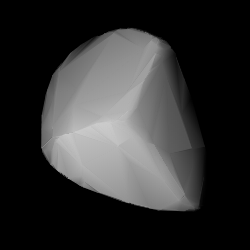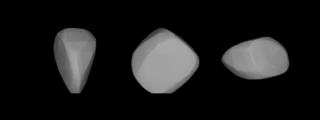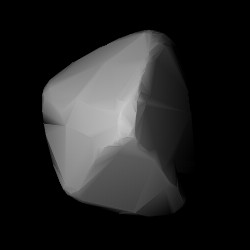Related Research Articles
1826 Miller, provisional designation 1955 RC1, is a stony Eoan asteroid from the outer region of the asteroid belt, approximately 24 kilometers in diameter.
1018 Arnolda, provisional designation 1924 QM, is a stony asteroid from the central regions of the asteroid belt, approximately 16 kilometers in diameter. It was discovered on 3 March 1924, by German astronomer Karl Reinmuth at the Heidelberg-Königstuhl State Observatory in southwest Germany. The asteroid was named after physicist Arnold Berliner.
1033 Simona, provisional designation 1924 SM, is a stony Eoan asteroid from the outer regions of the asteroid belt, approximately 20 kilometers in diameter. The asteroid was discovered by George Van Biesbroeck in 1924, who named it after his daughter Simona.
1049 Gotho, provisional designation 1925 RB, is a carbonaceous asteroid from the outer region of the asteroid belt, approximately 53 kilometers in diameter. It was discovered on 14 September 1925, by German astronomer Karl Reinmuth at Heidelberg Observatory in southwest Germany. Although the name of the asteroid is a masculine German name, it is not known to refer to a particular individual.
1112 Polonia, provisional designation 1928 PE, is an Eoan asteroid from the outer regions of the asteroid belt, approximately 38 kilometers in diameter. Discovered by Soviet astronomer Pelageya Shajn at Simeiz in 1928, it was the first asteroid discovery made by a woman. The L-type asteroid has a long rotation period of 82.5 hours, and was named for the country of Poland.
2531 Cambridge, provisional designation 1980 LD, is a stony Eoan asteroid from the outer regions of the asteroid belt, approximately 20 kilometers in diameter. It was discovered on 11 June 1980, by American astronomer Edward Bowell at Lowell's Anderson Mesa Station in Arizona, United States. The asteroid was named for the Cambridge University.
1411 Brauna, provisional designation 1937 AM, is a stony Eoan asteroid from the outer regions of the asteroid belt, approximately 31 kilometers in diameter. It was discovered on 8 January 1937, by German astronomer Karl Reinmuth at the Heidelberg-Königstuhl State Observatory in Germany. The asteroid was named after Margret Braun, wife of Heidelberg astronomer Heinrich Vogt.

1555 Dejan, provisional designation 1941 SA, is an asteroid from the background population of the central regions of the asteroid belt, approximately 22 kilometers in diameter. It was discovered on 15 September 1941, by Belgian astronomer Fernand Rigaux at the Royal Observatory of Belgium in Uccle. The asteroid was named after Dejan Đurković, son of Serbian astronomer Petar Đurković.
1199 Geldonia, provisional designation 1931 RF, is an Eoan asteroid from the outer regions of the asteroid belt, approximately 32 kilometers in diameter. It was discovered on 14 September 1931, by Belgian astronomer Eugène Delporte at the Royal Observatory of Belgium in Uccle. The asteroid was named after the Belgian town of Jodoigne.
1532 Inari, provisional designation 1938 SM, is a stony Eoan asteroid from the outer regions of the asteroid belt, approximately 28 kilometers in diameter. Discovered by Yrjö Väisälä at Turku Observatory in 1938, it was later named for Lake Inari in northern Finland.
2046 Leningrad, provisional designation 1968 UD1, is a carbonaceous Themistian asteroid from the outer regions of the asteroid belt, approximately 24 kilometers in diameter. It was discovered on 22 October 1968, by Soviet astronomer Tamara Smirnova at the Crimean Astrophysical Observatory in Nauchnij, on the Crimean peninsula. The asteroid was named for the Soviet city of Leningrad (now St. Petersburg).

1607 Mavis, provisional designation 1950 RA, is a stony asteroid from the central region of the asteroid belt, approximately 12 kilometers in diameter. It was discovered on 3 September 1950, by South African astronomer Ernest Johnson at Johannesburg Observatory in South Africa. It was later named after the wife of astronomer Jacobus Bruwer.

1291 Phryne, provisional designation 1933 RA, is an Eoan asteroid from the outer regions of the asteroid belt, approximately 27 kilometers in diameter. It was discovered on 15 September 1933, by Belgian astronomer Eugène Delporte at the Royal Observatory of Belgium in Uccle. The asteroid was named after the ancient Greek courtesan Phryne.

1364 Safara, incorrectly designated 1935 VB, is an Eoan asteroid from the outer regions of the asteroid belt, approximately 25 kilometers in diameter. It was discovered on 18 November 1935, by French astronomer Louis Boyer at the Algiers Observatory in Algeria, North Africa. The asteroid should have been designated 1935 WB, as the letter "V" only covers discoveries made during 1–15 November. It was named after André Safar, presumably an acquaintance of the discoverer from Algiers.
3333 Schaber, provisional designation 1980 TG5, is a dark background asteroid from the outer regions of the asteroid belt, approximately 26 kilometers (16 miles) in diameter. It was discovered on 9 October 1980, by American astronomer Carolyn Shoemaker at the Palomar Observatory in California. The presumably elongated C-type asteroid has a rotation period of 10.97 hours. It was named after American geologist Gerald Schaber of the USGS.
1737 Severny, provisional designation 1966 TJ, is a stony Eoan asteroid from the outer region of the asteroid belt, approximately 21 kilometers in diameter.
1258 Sicilia, provisional designation 1932 PG, is a dark background asteroid from the outer regions of the asteroid belt, approximately 44 kilometers in diameter. It was discovered on 8 August 1932, by astronomer Karl Reinmuth at the Heidelberg-Königstuhl State Observatory in southwest Germany. The asteroid was named after the Italian island of Sicily.

2120 Tyumenia is a dark background asteroid, approximately 45 kilometers in diameter, located in the outer regions of the asteroid belt. It was discovered on 9 September 1967, by Soviet astronomer Tamara Smirnova at the Crimean Astrophysical Observatory in Nauchnyj, on the Crimean peninsula. The asteroid was named for the now Russian district of Tyumen Oblast in Western Siberia.
2752 Wu Chien-Shiung, provisional designation 1965 SP, is an Eoan asteroid from the outer regions of the asteroid belt, approximately 16 kilometers in diameter. It was discovered on 20 September 1965, by astronomers at Purple Mountain Observatory in Nanking, China. The asteroid has a long rotation period of 36.3 hours. It was named for Chinese-American nuclear physicist Chien-Shiung Wu.
1887 Virton, provisional designation 1950 TD, is a stony Eoan asteroid from the outer region of the asteroid belt, approximately 21 kilometers in diameter. It was discovered by Belgian astronomer Sylvain Arend at the Royal Observatory of Belgium in Uccle on 5 October 1950, and named after the Belgian town of Virton.
References
- 1 2 3 4 "JPL Small-Body Database Browser: 1834 Palach (1969 QP)" (2016-11-23 last obs.). Jet Propulsion Laboratory . Retrieved 8 June 2017.
- 1 2 3 Schmadel, Lutz D. (2007). "(1834) Palach". Dictionary of Minor Planet Names. Springer Berlin Heidelberg. p. 147. doi:10.1007/978-3-540-29925-7_1835. ISBN 978-3-540-00238-3.
- 1 2 3 4 5 6 "LCDB Data for (1834) Palach". Asteroid Lightcurve Database (LCDB). Retrieved 15 December 2016.
- 1 2 "Asteroid 1834 Palach – Nesvorny HCM Asteroid Families V3.0". Small Bodies Data Ferret. Retrieved 26 October 2019.
- 1 2 3 Masiero, Joseph R.; Mainzer, A. K.; Grav, T.; Bauer, J. M.; Cutri, R. M.; Dailey, J.; et al. (November 2011). "Main Belt Asteroids with WISE/NEOWISE. I. Preliminary Albedos and Diameters". The Astrophysical Journal. 741 (2): 20. arXiv: 1109.4096 . Bibcode:2011ApJ...741...68M. doi:10.1088/0004-637X/741/2/68 . Retrieved 15 December 2016.
- 1 2 3 4 Mainzer, A.; Grav, T.; Masiero, J.; Hand, E.; Bauer, J.; Tholen, D.; et al. (November 2011). "NEOWISE Studies of Spectrophotometrically Classified Asteroids: Preliminary Results". The Astrophysical Journal. 741 (2): 25. arXiv: 1109.6407 . Bibcode:2011ApJ...741...90M. doi:10.1088/0004-637X/741/2/90.
- 1 2 3 4 Usui, Fumihiko; Kuroda, Daisuke; Müller, Thomas G.; Hasegawa, Sunao; Ishiguro, Masateru; Ootsubo, Takafumi; et al. (October 2011). "Asteroid Catalog Using Akari: AKARI/IRC Mid-Infrared Asteroid Survey". Publications of the Astronomical Society of Japan. 63 (5): 1117–1138. Bibcode:2011PASJ...63.1117U. doi:10.1093/pasj/63.5.1117. (online, AcuA catalog p. 153)
- 1 2 Pligge, Zachary; Monnier, Adam; Pharo, John; Stolze, Kellen; Yim, Arnold; Ditteon, Richard (January 2011). "Asteroid Lightcurve Analysis at the Oakley Southern Sky Observatory: 2010 May". The Minor Planet Bulletin. 38 (1): 5–7. Bibcode:2011MPBu...38....5P. ISSN 1052-8091 . Retrieved 15 December 2016.
- 1 2 Behrend, Raoul. "Asteroids and comets rotation curves – (1834) Palach". Geneva Observatory . Retrieved 15 December 2016.
- ↑ Veres, Peter; Jedicke, Robert; Fitzsimmons, Alan; Denneau, Larry; Granvik, Mikael; Bolin, Bryce; et al. (November 2015). "Absolute magnitudes and slope parameters for 250,000 asteroids observed by Pan-STARRS PS1 - Preliminary results". Icarus. 261: 34–47. arXiv: 1506.00762 . Bibcode:2015Icar..261...34V. doi:10.1016/j.icarus.2015.08.007 . Retrieved 15 December 2016.
- 1 2 "1834 Palach (1969 QP)". Minor Planet Center. Retrieved 15 December 2016.
- ↑ Nesvorný, D.; Broz, M.; Carruba, V. (December 2014). "Identification and Dynamical Properties of Asteroid Families". Asteroids IV. pp. 297–321. arXiv: 1502.01628 . Bibcode:2015aste.book..297N. doi:10.2458/azu_uapress_9780816532131-ch016. ISBN 978-0-8165-3213-1.
- ↑ "MPC/MPO/MPS Archive". Minor Planet Center. Retrieved 15 December 2016.